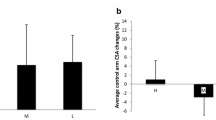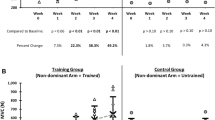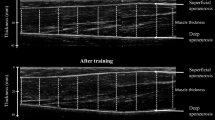Summary
This study investigated whether isokinetic strength training might induce changes in static and dynamic power already achieved as a result of isometric strength training. The subjects were twelve males. The isometric strength and dynamic power of elbow flexors were tested by means of an electric dynamometer and fly-wheel every two weeks. During the first 8 weeks all subjects trained the elbow flexors isometrically at four different positions of elbow joints. This training produced 27–36% gains in isometric strength and 34–46% in power. Thereafter the subjects were divided into two groups: the FG group who trained isokinetically at a fast velocity of 157‡·s−1, and the SG group at slow velocity of 73‡·s−1. After 6 weeks of training, the FG group produced a significant gain in power with light equivalent masses and the SG group did so with heavy equivalent masses. Neither group showed change in isometric strength.
Similar content being viewed by others
References
Caiozzo JV, Perrine JJ, Edgerton VR (1981) Training-induced alterations of the in vivo force-velocity relationship of human muscle. J Appl Physiol: Respirat Environ Exercise Physiol 46: 96–99
Clarke DH (1973) Adaptation in strength and muscular endurance resulting from exercise. In: Wilmore JH (ed) Exercise sports sciences reviews. Academic Press, New York, pp 73–102
Costill DL, Coyle EH, Fink WH, Lesmes GR, Witzman HA (1979) Adaptation in skeletal muscle following strength training. J Appl Physiol: Respirat Environ Exercise Physiol 46: 96–99
Coyle EF, Feiring TC, Rotkis RW, Cote III, Roby FB, Lee W, Wilmore JH (1981) Specificity of power improvements through slow and fast isokinetic training. J Appl Physiol 51: 1437–1442
Delome TL (1945) Restraction of muscle power by heavy resistance exercise. J Bone Joint Surg 27: 645–667
Hansen JW (1967) Effect of dynamic training on the isometric endurance of the elbow flexors. Int Z Angew Physiol Einschl Arbeitsphysiol 23: 367–370
Hettinger TH (1961) Physiology of strength. C. C. Thomas, Springfield, Illinois
Hill AV (1922) Maximum work and mechanical efficiency of human muscles and their most economical speed. J Physiol 56: 19–41
Hislop HJ, Perrine JJ (1967) The isokinetic concept of exercise. Phys Ther 47: 114–117
Komi PV, Viitasalo JT, Rauramaa R, Vihko V (1978) Effect of isometric strength training on mechanical, electrical, and metabolic aspects of muscle function. Eur J Appl Physiol 40: 45–55
Lesmes GR, Costill DL, Coyle EH, Fink WJ (1978) Muscle strength and power changes during maximal isokinetic training. Med Sci Sports 10: 266–269
Milner-Brown HS, Stein RB, Lee RG (1975) Synchronization of human motor units: possible role of exercise and surgical reflexes. Electroencephalogr Clin Neurophysiol 38: 245–254
Moffroid MT, Whipple RH, Hofosh J, Lowman E, Thistle H (1969) A study of isokinetic exercise. Phys Ther 49: 735–746
Moffroid MT, Whipple RH (1970) Specificity of speed of exercise. Phys Ther 50: 1692–1699
Pipes TV, Wilmore JH (1975) Isokinetic vs. isotonic strength training in adult men. Med Sci Sports 7: 262–274
Smith MJ, Melton P (1981) Isokinetic versus isotonic variable-resistance training. Am J Sports Med 9: 275–279
Thistle HG, Hislop HJ, Moffroid M, Lowman EW (1967) Isokinetic contraction: a new concept of resistance exercise. Arch Phys Med Rehabil 48: 279–282
Van Oteghen SL (1975) Two speeds of isokinetic exercise as related to vertical jump performance of woman. Res Q 96: 78–84
Author information
Authors and Affiliations
Rights and permissions
About this article
Cite this article
Kanehisa, H., Miyashita, M. Effect of isometric and isokinetic muscle training on static strength and dynamic power. Europ. J. Appl. Physiol. 50, 365–371 (1983). https://doi.org/10.1007/BF00423242
Accepted:
Issue Date:
DOI: https://doi.org/10.1007/BF00423242




